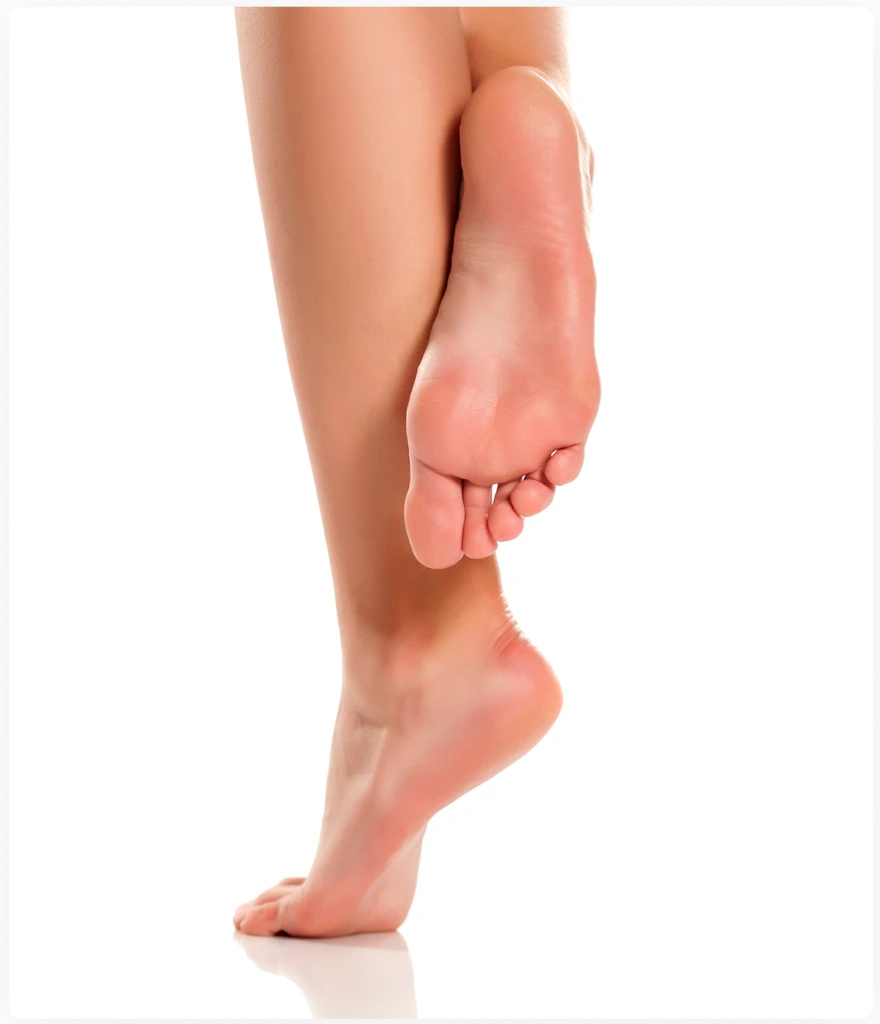Hallux valgus, or bunions, is a progressive bone and joint disorder in the feet. This condition appears as a bony bump on the side of the big toe joint. Hallux valgus is caused by a structural problem in the bones of the toes and foot, with the most affected area being the first metatarsophalangeal joint. As a result of this deformity, the foot cannot line up correctly.
Generally speaking, the symptoms of bunions appear during adulthood. However, teenagers and children can also experience them. If bunions occur near the base of the little toe, they are called “tailor’s bunions.”

Many researchers believe that bunions result from genetics, where parents transfer the genes responsible for bone structure to their children. However, ill-fitting shoes and other problems may also contribute to this condition. Here are the most common risk factors:
The primary role of conservative procedures is to reduce the pain and swelling often seen with hallux valgus. Our doctors may prescribe the following treatments:
Surgical correction is a proven and effective treatment to resolve bunion deformity and pain, especially when non-invasive measures fail to do so. The main indications for surgery include:
The goal of the surgery is to realign the metatarsophalangeal (MTP) joint, relieve pain, and correct other deformities of the toe. Operative interventions allow our patients to engage in an active, healthy lifestyle without being limited by foot discomfort.

This standard bunion surgery involves making precise bone cuts to realign the joint. Our surgeon cuts the metatarsal bone, repositions it to reduce the protrusion, and secures it with screws, pins, or plates. The procedure addresses both the visible bump and the underlying structural misalignment. Recovery typically requires 6-8 weeks of limited weight-bearing, with full healing taking several months. Here are the specific techniques we can use:
This straightforward procedure focuses solely on removing the bony prominence that forms the bunion. Our surgeon shaves away the protruding portion of the metatarsal head without realigning the bone or joint. Since it does not correct the underlying misalignment, exostectomy is typically only recommended for mild cases or elderly patients who want minimal intervention. Recovery is generally quicker than more extensive procedures.
This technique involves removing the damaged joint surfaces and fusing the bones with screws, plates, or other elements. Arthrodesis eliminates joint movement but provides excellent stability and pain relief. This procedure is typically reserved for severe bunions, arthritic joints, or failed previous surgeries. Recovery requires strict non-weight-bearing for several weeks, with complete fusion taking up to three months.
This surgery addresses bunions at their source by fusing the joint between the metatarsal and midfoot bones. By correcting the instability at this junction, the Lapidus procedure prevents the metatarsal from drifting outward. This technique is especially effective for hypermobile joints or recurrent bunions. Recovery requires 6-8 weeks of non-weight-bearing and may include protective boot use for several additional weeks.
This technique involves removing part of the proximal phalanx (the base of the big toe) to reduce pain and deformity. After bone removal, our surgeon may reposition the tendons to improve toe alignment. The Keller procedure is generally reserved for elderly patients with limited mobility or severely arthritic joints who do not require full joint function. Recovery typically takes 4-6 weeks, though the toe may be somewhat shortened and have reduced strength.
This bunion corrective procedure focuses on reconstructing or replacing the damaged joint surface at the base of the big toe. The surgeon removes arthritic bone and cartilage, then either reshapes the remaining surfaces or inserts an implant to maintain joint space and function. Arthroplasty is typically reserved for older patients with severe arthritis or joint damage who need toe flexibility but want to remove painful bunions. This procedure can provide significant relief and improved motion. However, implants may wear over time and require future revision. Our doctors thoroughly evaluate each patient to determine if a joint replacement is needed in their case.
This approach uses specialized instruments inserted through tiny incisions to correct the bunion. Our surgeon can remove bone, reposition the joint, and secure it with minimal disruption to surrounding tissues. Benefits include less scarring, reduced pain, and faster recovery than traditional open operation. Our doctors may also perform arthroscopic surgery using a tiny camera to enhance precision.
Bunion surgery is often considered when conservative treatments no longer provide relief from pain or discomfort. The following groups of individuals are typically eligible for operative interventions:
Generally speaking, the symptoms of bunions appear during adulthood. However, teenagers and children can also experience them. If bunions occur near the base of the little toe, they are called “tailor’s bunions.”

Bunion surgery offers significant relief for those suffering from persistent pain and discomfort. While recovery and outcomes vary, such treatments offer many benefits, improving the quality of life and mobility. Here are the key advantages of bunion surgery:

Foot HealthCare Associates takes a comprehensive approach to bunion surgery, combining advanced techniques with a deep commitment to individualized care. Our practice uses innovative methods, such as small-incision procedures and arthroscopy, to achieve faster recovery and reduce post-operative discomfort. Our podiatrists have decades of experience in complex foot and ankle surgeries and conservative treatments, ensuring that every patient receives the most appropriate care for their needs. By offering clear communication and a supportive environment, Foot HealthCare Associates fosters trust and confidence, achieving excellent results and ensuring long-term well-being.

If you need treatment for bunions, call our office in Novi, Livonia, Howell, or Southfield at 248-258-0001 to schedule a consultation.